Traditional catering emphasizes classic menus and formal presentations, often highlighting regional or cultural heritage with time-honored recipes and elegant service styles. Contemporary catering prioritizes innovative, customizable menus with a focus on fresh, seasonal ingredients, interactive food stations, and casual, experiential dining. Both approaches cater to different event styles and guest preferences, balancing nostalgia with modern culinary trends.
Table of Comparison
| Feature | Traditional Catering | Contemporary Catering |
|---|---|---|
| Menu Style | Classic dishes, fixed menu | Modern, diverse, customizable options |
| Service Format | Plated service, formal setup | Buffet, interactive stations, casual |
| Presentation | Formal plating, uniform style | Innovative plating, artistic and unique |
| Dietary Options | Limited specialties | Extensive, including vegan, gluten-free |
| Technology Integration | Minimal | Online ordering, real-time tracking |
| Environmental Impact | Traditional waste management | Eco-friendly, sustainable sourcing |
| Price Range | Moderate to high | Varies widely, often competitive |
Understanding Traditional Catering
Traditional catering emphasizes classic techniques, timeless recipes, and formal presentation styles rooted in cultural heritage. It often features set menus, standardized service protocols, and dishes that reflect regional or historical culinary practices. Understanding traditional catering involves recognizing its focus on consistency, elegance, and preserving culinary traditions for formal events and celebrations.
Defining Contemporary Catering
Contemporary catering emphasizes innovative menus, presentation, and service styles that reflect current culinary trends and diverse dietary preferences, contrasting the predictable, classic offerings of traditional catering. It integrates fresh, seasonal ingredients and artistic plating to create memorable dining experiences tailored to modern events and audiences. Technology and sustainability often play key roles in contemporary catering, enhancing efficiency and aligning with eco-conscious values.
Key Differences Between Traditional and Contemporary Catering
Traditional catering emphasizes classic menus, formal service styles, and large-scale events with set meal courses, often reflecting cultural or regional heritage. Contemporary catering prioritizes innovative, customizable menus, casual service, and experiential dining incorporating global flavors, dietary preferences, and sustainability practices. Key differences include the approach to presentation, flexibility in menu design, and adaptation to modern lifestyle trends.
Menu Styles: Classic vs. Modern Offerings
Traditional catering menus emphasize classic dishes rooted in cultural and regional heritage, often featuring comfort foods and familiar flavors that appeal to a wide audience. Contemporary catering embraces innovative menu styles with fusion cuisine, plant-based options, and artisanal ingredients, catering to evolving dietary trends and gourmet preferences. The choice between classic and modern offerings influences event ambiance, guest experience, and catering brand positioning.
Presentation and Service Variations
Traditional catering emphasizes classic presentation styles, featuring formal table settings, uniform plating, and silverware service, reflecting time-honored customs. Contemporary catering showcases innovative presentation techniques, such as deconstructed dishes, interactive food stations, and minimalist plating, enhancing visual appeal and guest engagement. Service variations in traditional catering often include formal waiter service, while contemporary catering favors buffet-style, self-service, or casual drop-off options to accommodate diverse event formats.
Customization and Flexibility
Traditional catering often follows fixed menus and standardized service styles, limiting customization options for clients. Contemporary catering emphasizes flexibility, offering tailored menu selections, dietary accommodations, and personalized service to meet diverse customer preferences. Embracing customization enhances guest experience and aligns with modern event trends prioritizing unique, client-driven culinary solutions.
Technology Integration in Catering Services
Traditional catering often relies on manual processes and face-to-face interactions for order management and event coordination. Contemporary catering integrates advanced technology such as online booking platforms, automated inventory systems, and real-time communication tools, enhancing efficiency and customer experience. Data analytics and AI-driven personalization enable modern caterers to tailor menus and services to client preferences with greater precision.
Budget Considerations and Cost-effectiveness
Traditional catering often involves higher costs due to elaborate ingredients, extensive manpower, and classic presentation styles, making it less budget-friendly for large events. Contemporary catering emphasizes innovative, streamlined menus with locally sourced ingredients and minimalistic setups that reduce overhead expenses. Cost-effectiveness is achieved through flexibility in portion sizes, seasonal menu planning, and efficient service models that cater to modern budget constraints.
Sustainability and Eco-Friendly Practices
Traditional catering often relies on bulk purchasing and disposable packaging, resulting in higher waste and environmental impact. Contemporary catering emphasizes sustainability through locally sourced ingredients, biodegradable materials, and zero-waste policies to minimize carbon footprints. Incorporating plant-based menus and energy-efficient kitchen equipment further advances eco-friendly practices in modern catering services.
Choosing the Right Catering Style for Your Event
Selecting between traditional catering and contemporary catering depends on the event's theme, guest preferences, and desired ambiance. Traditional catering emphasizes classic dishes and formal service styles, ideal for weddings or corporate events seeking elegance and nostalgia. Contemporary catering offers innovative menu options and flexible presentation, perfect for casual gatherings or events aiming for a modern, interactive dining experience.
Traditional Catering vs Contemporary Catering Infographic

 bizdif.com
bizdif.com